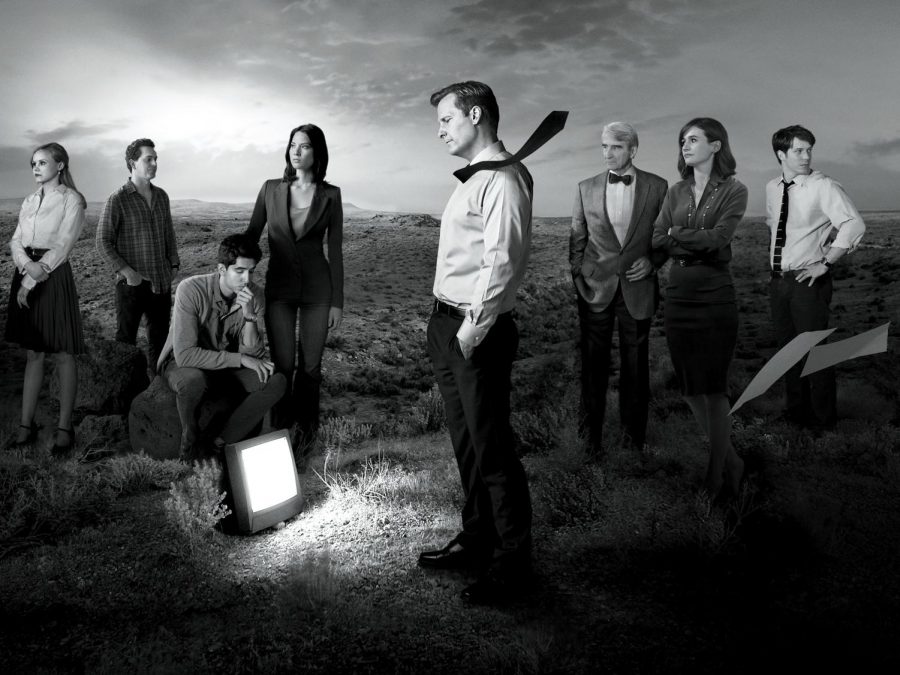The Newsroom’s First Season (Still) Makes Its Mark
March 15, 2019
Will McAvoy, Atlantis World Media (AWM), and News Night all stem from Aaron Sorkin’s mind, but The Newsroom addresses real issues before anyone could anticipate their impact. The political drama should be a household name like Sorkin’s other hits including The West Wing and The Social Network, but it was prescient. The 2012 HBO drama opens with McAvoy, during an out-of-character rant at a university lecture, professing the flaws of the United States and its two major political parties.
The hour-long episodes follow the anchor, played by Jeff Daniels, his staff, and their relationships in a dramatized look behind the scenes of a newsroom. This incident that opens the series goes viral and pivots the entire program. McAvoy begins a full-fledged attack on his own industry and how television journalism is reported. He is done being the “Jay Leno of anchors” and decides to focus his hour long program five times a week on reporting real news. His goal is to inform his audience -not to please them- much to the dismay of the executives upstairs. He criticizes other journalists, gossip media, The Tea Party, the Koch Brothers, immigration, mass shootings, gun rights, and the US government in the first five episodes of the show. Off the air, the staff deals with personal drama, relationships, and journalistic integrity.
Jeff Daniels, Emily Mortimer, and Sam Waterston star in the ensemble cast made possible by HBO’s deep pockets. McAvoy and Mackenzie McHale, Mortimer’s character, have a complicated, hidden past that become exposed within the first few episodes. The push and pull of the executive producer, played by Mortimer, and Daniels’ news anchor is heightened by their romantic baggage. Charlie Skinner, the director of the news division at AWM, played by Waterston, is always at McAvoy’s side and proves he is loyal to him, even if means disobeying the network.
The show tinkers on the edge of eye rolling over-the-top drama and exciting cliff hanging storylines. Each episode captures roughly one week of the previous year’s news. The characters rush to organize a nightly news lineup every day, as Sorkin captures the drama and intensity that follows a newsroom. He uses this foundation to develop the relationships between the characters.
The Hollywood Reporter, Rotten Tomatoes, and The New York Times all agree that the show is “too preachy.” Jeff Daniels’ character has a nine-figure contract with AWM and he decides to fix the United States’ flaws by connecting with his viewers; most who are from the middle class. As someone who agrees with the opening rant professing the flaws of America, I find his monologues moving and empowering, yet I understand how the writing can feel like a personal attack on the audience and sound over the top.
Similar to Sorkin’s other hits, one of the best parts of The Newsroom is its dialogue. It’s sharp, clever, and witty. Sorkin does a phenomenal job, as do the actors, of capturing the characters’ emotion and investment in their work. They’re smart and they know it. McAvoy graduated college at 19 and was a prosecutor for the District Attorney in Brooklyn before his current job at News Night. Sloan Sabbith, played by Olivia Munn, is AWM’s senior financial reporter who has multiple Ph.d.’s and is a professor at Columbia University. Munn plays this character brillanitly. She is intelligent, witty, passionate, and socially awkward – the perfect combination to make her character believable. The development of her character over the first season is the most entertaining to watch. When McHale is hired as the executive producer of the show, she allots Sabbith five minutes a show to report on the economy. Throughout the season, she begins to gain McHale’s trust and therefore, more airtime at McAvoy’s desk and on the show. This is followed by conflict and drama both on and off the air.
During its initial broadcast, critics accused Sorkin of schooling newscasters as to how they should cover major current events. The show relives the most recent major news stories including the killing of Osama Bin Laden, the shooting of Congresswoman Giffords, and the Valdez Oil Spill. News Night captures and reports these stories flawlessly. The television journalism industry felt attacked by Sorkin for not covering these major events realistically, the way they would have happened in real time. McAvoy and the team heroically waited to call the death of Congresswoman Giffords after NPR and other real major organizations jumped the gun on the call. When the Congresswoman was reported still alive, they celebrated themselves for being better than their competition.
As a young adult viewer, watching The Newsroom is my first time digesting these significant current events. While the reporting is dramatized and rehearsed, the excitement of finding, editing, and reporting the story both behind the scenes and in front of the camera is exhilarating to watch and understand. I would have never fully understood these current events without watching the show.
McAvoy was talking about America’s polarization before the rest of the country started to. Sorkin’s genius is that he can anticipate the future. In the show, and even more today, Americans will change the channel if they do not agree with the reporter, and usually the truth. More and more, the audience wants to hear what they already know, not what challenges them. Sorkin knows this and forces the audience to struggle through the discomfort of something new and not always easy to hear. The team at News Night is an excellent portrayal of journalism. They work hard, follow leads (and their gut), and are invested in the final product – characteristics hard to come by and needed in the current generation of young adults.






































